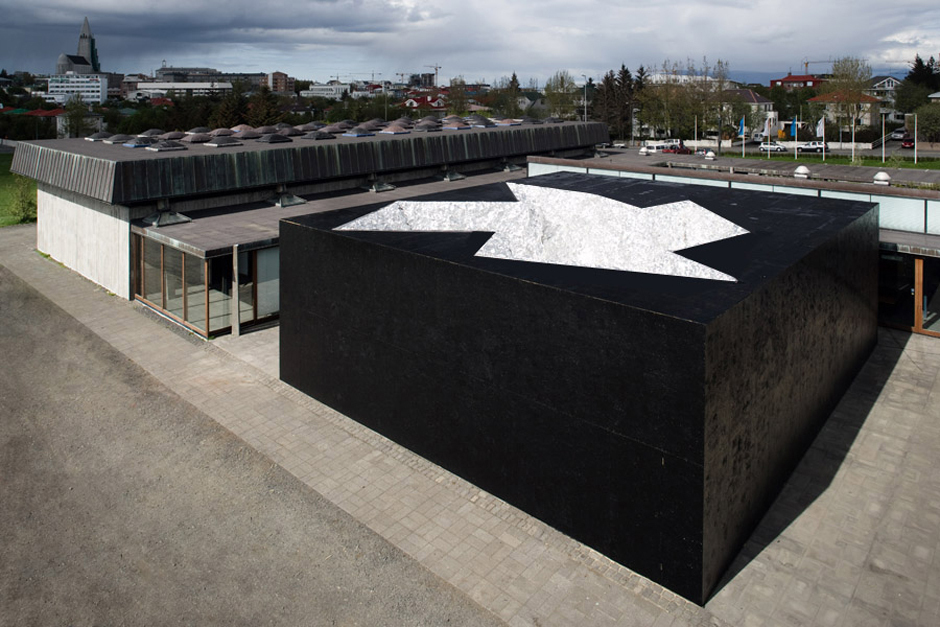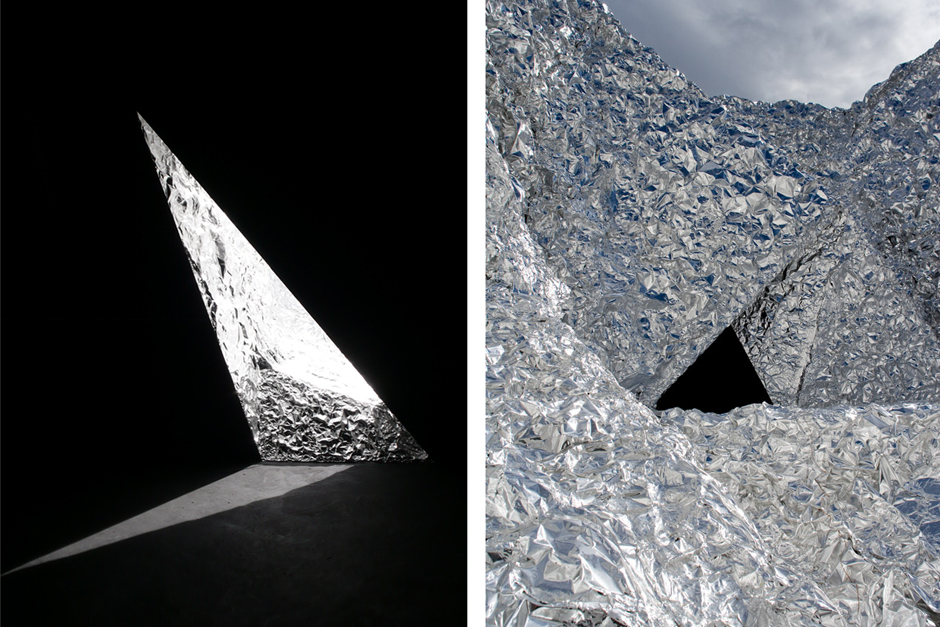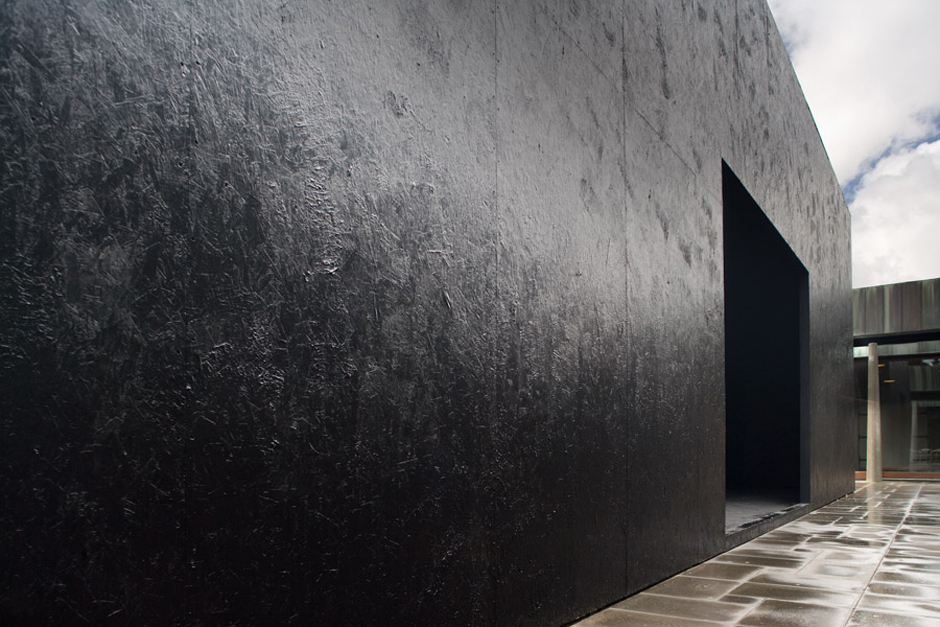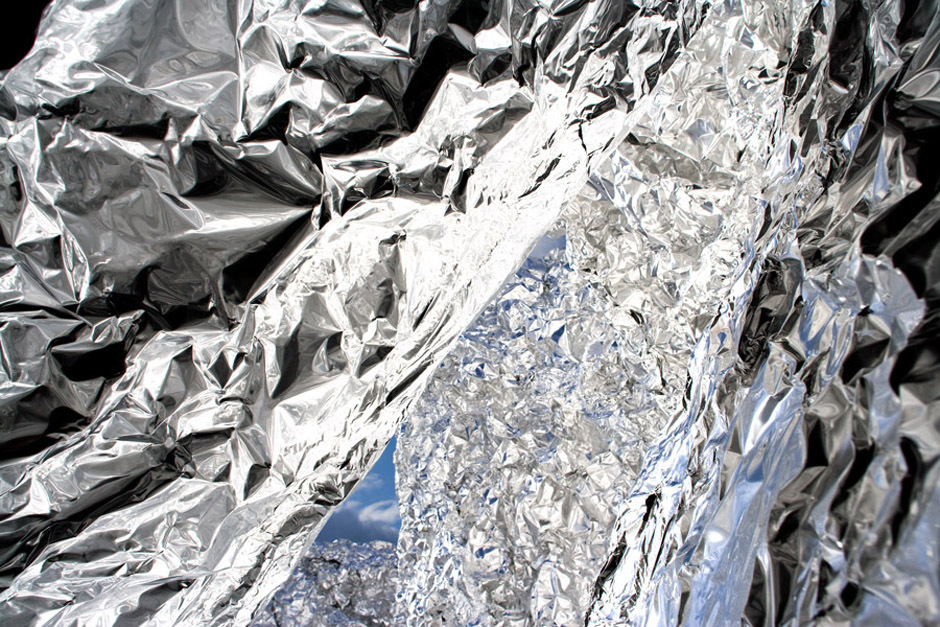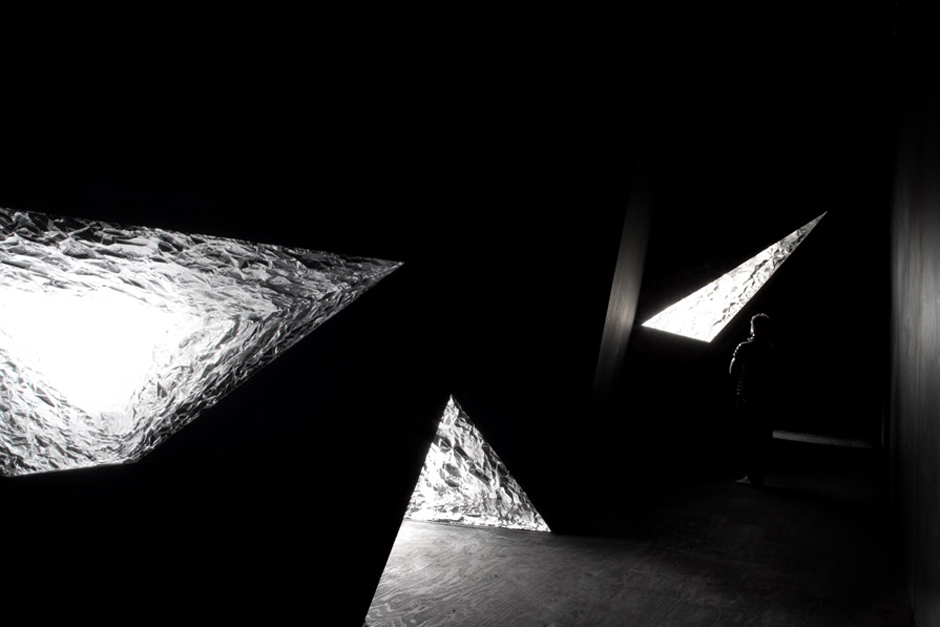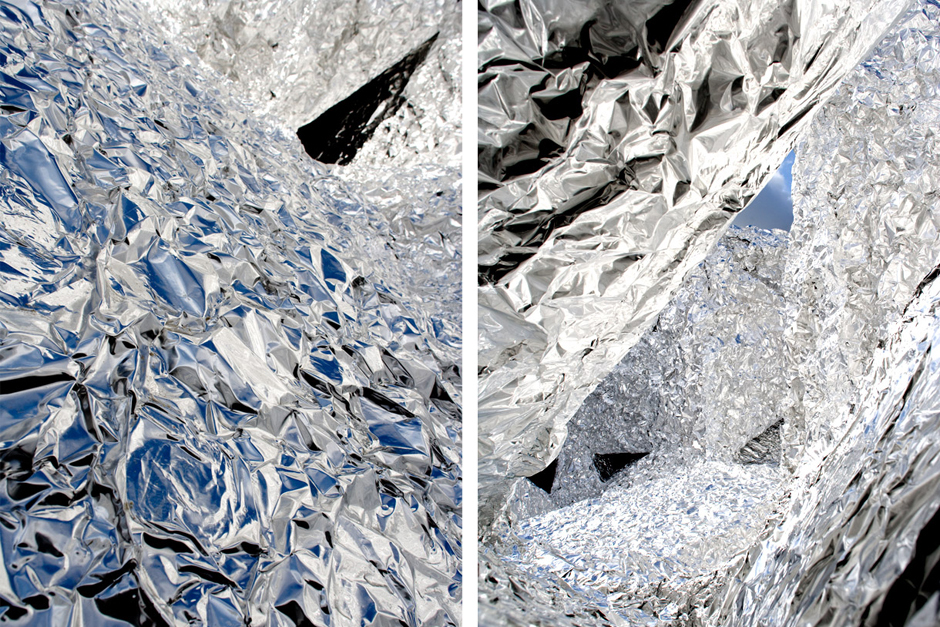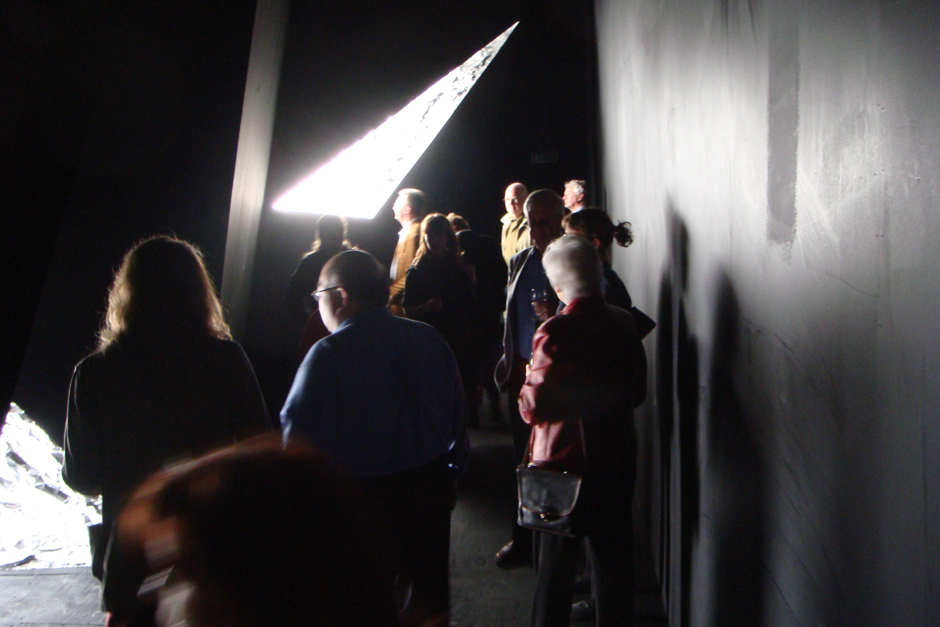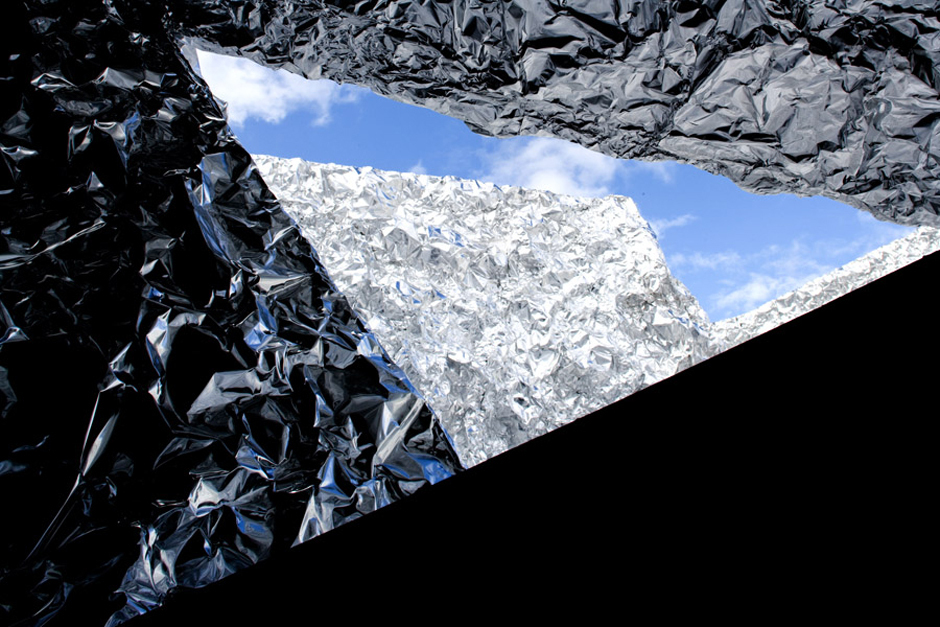
A view through a portal to into the geode (Photo: Rafael Pinho)
Aluminati Installation, Reykjavic Art Museum
Reykjavík
The Aluminati installation was constructed by BAM and designed in collaboration with Martha Schwartz, as part of the 2008 Reykjavik Experiment Marathon curated by Olafur Eliasson and Hans Ulrich Orbst. A charged political statement, Aluminati is intended to expose and address the current crisis of the Icelandic landscape. Aluminum foil, the primary medium of Aluminati, is a harbinger of the environmental dilemma that Iceland is facing. Aluminum smelting plants have set up to gorge themselves on one of Iceland’s greatest natural resources: free energy from geothermal heat sources. The presence of these foreign companies is a point of controversy for Icelanders, who associate their national identity with their pristine landscape. The Icelandic Government, however, cannot refuse this opportunity because the aluminum business looks like the last resort for saving Iceland’s bankrupt economy. Aluminati makes a call for discourse about nature in the 21st century. Icelanders can choose to view nature as untouchable and sacred. Or, they can choose to view humans as a part of nature. In Martha’s point of view, the way Icelanders currently think about their landscape is not so different from the way we Americans think about ours. As Americans, we cling to a fantasy wilderness too. Two hundred years after settling, we still think we’re living on a wide-open continent of beauty and natural riches. Both Icelanders and Americans perceive nature as hallowed realm, however, there is an extreme difference between how we think of nature and how we use it. In America, at the same time we sell off land and develop it, we are under the delusion that nature is untamed, wild and “untouchable”. A lot of us still think we’re living in a Hudson River painting. It’s time to redefine our conception of and relationship to nature. nature as pristine wilderness is just a fantasy. Americans struggle with a twisted nostalgia for what existed in our “back yards” centuries ago, as though it were a lost Paradise. Science, technology, politics, and economics have evolved since the mid-19th century, but we persist to glorify nature to the point where it is now a contentious moral issue to even consider designing nature that can engage today’s complex environmental systems. For too long, we we’ve been carrying moral baggage about nature, and as a result, we’re falling behind. If Americans want to act as leaders for generations to come, then we have to accept that increasingly, nature is very UN-natural. We refuse to accept that our environment is quickly becoming a product of our will. The truth is that nature includes us: nature is rotting teeth, balding heads, and birth control. Most of us live by the mantra that humans are the enemy of nature. But if we consider that humans are a part of nature, then we can begin to accept the idea that manipulating our environment is a sign of progress. Once we embrace the landscape as constructed, we will stop ignoring our ugly surroundings (think strip malls and parking lots) and start paying attention to the damage we are causing to our beloved nature. To build big box developments, promote sprawl, and lay down endless miles of highway degrades our environment not only visually, but also culturally and ecologically. Learning from America’s example, Icelanders can find reason to be proactive about managing change in their environment - change which is happening right now and which will continue to happen at an increasing rate. Iceland can look to America as an example of what not to do: we have allowed nature to visually degrade. When we ignore our surroundings - which is what happens when everything around you is unsightly - we cease to love it, and stop maintaining it. Civilization will fall to disarray if we continue to build cities that are bland, faceless, and ubiquitous. Aluminati aims to evoke reactions from visitors, to create emotion and connection to place and circumstance. In contrast to some decisions to treat aluminum like a bastard child, we think aluminum can be beautiful. Aluminum can conjure up the essence of a futuristic nature. A 500 sqm box set within the courtyard of Kjarvalsstadir Museum blocks sunlight which would otherwise penetrate circumambulatory hallways inside. Pupils dilate, and blinding bright shards of light create mesmerizing white shapes in space. A feeling of compression and claustrophobia in the dark walkways sets up a feeling of release and escape when looking through portals in the wall at the illuminated aluminum-encrusted interior of the “geode”. It feels cold, as though suspended in a glacier crevasse or alone on a glistening snowfield. Peering through a portal large enough to fit shoulders, an aluminum terrain comes slowly to focus. It appears heavy and mineral in texture. The color of reflections in the aluminum changes with the sky. The space beyond looms imposing, menacing, and seemingly infinite. There is something dangerous in this beauty. It is hoped that Aluminati has made it possible for us to feel allure, disgust, confusion, or anything at all, through the transformation of an ordinary, domestic material about which the world could care less, but which matters a great deal to Iceland. Rather than polarize around the issue of whether or not aluminum smelting plants should be located in Iceland, we can create community by initiating and shaping the development of a new nature. It is up to us to build on ideas which collectively define and control our present and future environment. (This project completed by BAM in the office of Martha Schwartz, Inc.) Project Facts Built as part of the Reykjavik Experiment Marathon Shown June through August 2008 Curated by Olafur Eliasson and Hans Ulrich Obrist Museum Director: Hafþór Yngvason Architectural: Skapa & Skerpa Structural Engineer: Alemenna Construction: Svidsmyndir
ALUMINATI装置
雷克雅未克市
由 Olafur Eliasson和Hans Ulrich Orbst组织的雷克雅未克市马拉松测试赛十分精彩,而作为测试赛的一部分,ALUMINATI由BAM构思,Martha Schwartz与BAM 共同设计。ALUMINATI作为一个负责任的政治声明,旨在揭露和说明冰岛景观当前存在的危机。 作为ALUMINATI的主要媒介,铝箔是冰岛现在面临环保困境的先声。炼铝厂已经设立,以吞噬冰岛最大的免费自然资源----地热能。冰岛人把他们的民族特性与原生态景观联系到一起,所以这些外企的存在也就成了他们讨论的焦点。然而,冰岛政府并不想失去这个机会,因为铝业好像要成为拯救濒临破产的冰岛经济的最后一根稻草。 ALUMINATI也参与到了这场关于21世纪自然的对话之中。要么视大自然为神圣不可触动之地,要么视人类为大自然不可分割的一部分,冰岛人有权利在二者间作出选择。 依Martha的看法,当今冰岛人思考当地景观的方式和我们美国人思考美国景观的方式没什么区别,我们美国人也坚守着虚构的荒原。来到北美已经两百多年了,我们仍然认为,我们是生活在一片美丽而富饶的广阔大陆上。尽管冰岛人和美国人都视大自然为神圣之地,但在如何思考自然、利用自然上却有很大差异。 在美国,我们在买卖土地和开发土地的同时,又在幻想大自然是未被驯服的、狂野的和遥不可及的。很多美国人现在还认为:我们正生活在哈德逊河(Hudson River)的美丽图画之中。现在是时候了!是重新定义大自然,重新确定我们与大自然之间 的关系的时候了。 作为原始荒野的大自然只是一种幻觉罢了。美国人带着扭曲的怀旧情结,一直在为几个世纪以前的美国后院而斗争,好像那里曾经是个失乐园似的。自19世纪中叶以来,科技、政治和经济都迅猛发展,但美国人仍很顽固,颂赞着大自然曾经的样子。而大自然曾经的样子现在是一个有争议性的道德话题,甚至有人考虑将大自然融入当今复杂的生态体系中。由于长久地背负着大自然的道德包袱,结果,我们落后了。 如果我们美国人想要子孙后代都扮演领导者的角色,那么我们就必须接受这样一个事实:大自然正变得越来越不自然。然而,我们却否认:我们的环境正在迅速的按着我们的意志改变。很多美国人都生活在这样的咒语之下:人类是大自然的敌人。但事实是:我们是大自然的一部分,也就是说自然包括蛀牙、节育和随年龄变化越来越少的头发。只要我们相信人类是大自然的一部分,那么我们就能开始接受这样的观点:改造环境是一种进步的表现。一旦我们接受景观是人造的这一观点,我们将不再忽视我们身边糟糕的环境(开始重视狭窄的商场和停车场),并且会更加关注我们给可爱的自然留下的垃圾。拓展城市,建商业开发区,修建看不到尽头的高速,这些不仅损害了我们的有形环境,也损害了文化、生态这些无形环境。 冰岛的环境现在在变化,将来在很大程度上还要继续变化。冰岛人从美国的教训中能够找中的有形环境,冰岛人可以以美国为戒避免这些行为的发生。我们周边的环境已经不堪入目,而我们却视而不见。我们已经不再热爱 我们的环境,更别说保护了。我们的城市是如此的平淡无味,如此的毫无个性,如此的遍地都是。如果我们再继续这样修建,我们辛辛苦苦创造的文明将变得支离破碎。 ALUMINATI旨在勾起游客的反应,并使游客与当地环境之间建立一种情感联系。很多人决定像对待私生子那样对待铝,我们与此相反,认为铝也有美丽的一面。铝可以使带有未来主义色彩的大自然的实质映入游客的脑海。 10Kjarvalsstadir博物馆院内有一个顶置盒,面积达500平方米。顶置盒反射了阳光,否则阳光就会折射到门厅内。阳光照到铝壳上,十分耀眼,再折射到室内,形成许多迷人的白色形状。 表面涂有铝层的晶洞内部已经照亮,当我们通过墙体上的洞孔往里看时,先是有一种在黑暗的步行道上行走时的压抑和恐惧之感,接着就转变为一种自由和解脱之感。感觉里面很冷,就好像挂在了冰缝上,又好像独自一人在亮晶晶的雪地上。洞孔很大,足可以容下人的肩膀。通过洞孔看,铝表地势正慢慢的向中间靠拢。顶置盒看上去很重而且铝质感也很好。反射在铝表面的颜色随着天空颜色的变化而变化。顶置盒的上方看上去时而壮观,时而凶险,时而没有尽头。这种美丽之下好像隐藏着某种危险。 铝材料在冰岛很常见,国际上可以对此不闻不问,但这种材料对于冰岛来说却是意义重大。通过这种材料进行改造,我们希望ALUMINATI能和人们建立一种情感,无论这种情感是称赞,是厌恶,是困惑,还是其他的任何情感。我们不是偏激的去争论冰岛是否应该设立炼铝厂的话题,而是去倡导新的大自然,塑造新的大自然和发展新的大自然,并以此为契机,创建一个人与自然和谐相处的环境。我们集思广益,确定现在的环境和将来的环境的范畴,并建设、管理好它们。(该项目由BAM在玛莎.施瓦兹公司完成) 工程有关方面: 雷克雅未克市(the Reykjavik)马拉松测试赛的起止日期是2008年6月到8月,由 Olafur Eliasson和Hans Ulrich Orbst组织完成,本设计是测试赛的一部分。 博物馆负责人:HafÞór Yngvason 建筑设计:Skapa and Skerpa公司 结构工程师:Alemenna公司 施工单位:Svidsmyndir公司 RELATED PROJECTS
